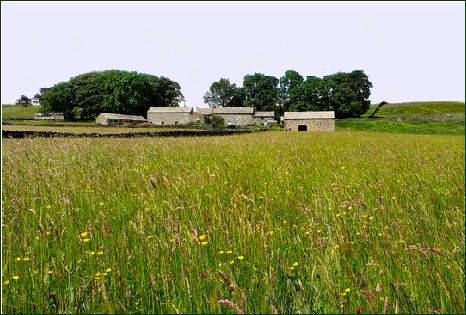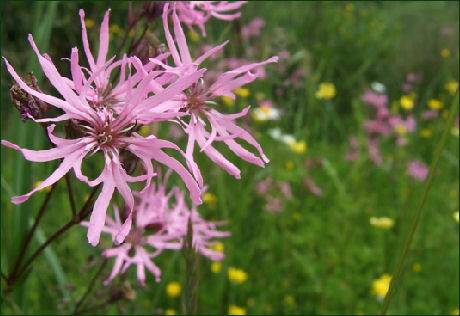Hannah's Meadow
OS grid reference:- NY 935 185
 Hannah's Meadow is a Site of Special Scientific Interest in the heart of the North Pennines Area of Outstanding Natural Beauty (A.O.N.B), which comprises of one of the most extensive and remote areas of upland England.
Hannah's Meadow is a Site of Special Scientific Interest in the heart of the North Pennines Area of Outstanding Natural Beauty (A.O.N.B), which comprises of one of the most extensive and remote areas of upland England.
Hannah's Meadow consists of three fields, located at Low Birk Hatt Farm, on the north side of Blackton Reservoir, in Baldersdale, some 7 km west of the village of Cotherstone. The site is named after Hannah Hauxwell, who lived alone at Low Birk Hat Farm whose farm it was for over fifty years.
Hannah Hauxwell, a then 46 year old spinster, rose rapidly to fame following a documentary entitled 'Too Long a Winter' made by Yorkshire Television and produced by Barry Cockcroft which detailed her extraordinary life in the early 1970's.
She lived a harsh and frugal existence, eeking out a living on an upper dales farm without any electricity or running water, which she had run by herself since the age of 35, following the deaths of her parents and uncle. Hannah's fierce determination in the face of great difficulty captured the nation's heart, following the documentary, she began to receive many letters of appreciation and a local business helped fund-raise to bring electricity to Low Birk Hatt Farm. A number of additional documentaries were filmed following this initial success.
 Due to the fact that Hannah Hauxwell employed traditional farming practices, with no re-seeding and no artificial fertilisers, the meadows are thought to be the least improved in upland Durham, and, as a result, have a very rich floral composition. Visit the Meadow in June and early July (Note - meadow is cut in mid July) to see traditional hay meadow flowers, such as meadow fox-tail, sweet vernal grass, crested dog’s tail, ragged robin (pictured right), wood crane's-bill, marsh-marigold, yellow-rattle, adders-tongue fern and globe-flower plus rare species such as frog orchid and moonwort.
Due to the fact that Hannah Hauxwell employed traditional farming practices, with no re-seeding and no artificial fertilisers, the meadows are thought to be the least improved in upland Durham, and, as a result, have a very rich floral composition. Visit the Meadow in June and early July (Note - meadow is cut in mid July) to see traditional hay meadow flowers, such as meadow fox-tail, sweet vernal grass, crested dog’s tail, ragged robin (pictured right), wood crane's-bill, marsh-marigold, yellow-rattle, adders-tongue fern and globe-flower plus rare species such as frog orchid and moonwort.
The pasture has a more acidic character with rushes and sedges domination and this supports breeding birds such as lapwing, skylark, redshank, curlew and meadow pipit.
Hannah eventually retired to a cottage in the village of Cotherstone, less than five miles (8 km) from Low Birk Hatt Farm. In 1988, Low Birk Hatt Farm was purchased by the Durham Wildlife Trust, which now manages it as Hannah's Meadows nature reserve; one of the farm buildings-which are excluded from the SSSI-has been renovated as an unmanned visitor centre. In order to preserve the special characteristics of the site, the Trust continues to manage the farm in the traditional manner.
The old barn in the top meadow has been converted into an un-manned visitor centre containing displays describing the life of Hannah Hauxwell, the importance of the meadows in Teesdale and the work of Durham Wildlife Trust. It is open all year round.
